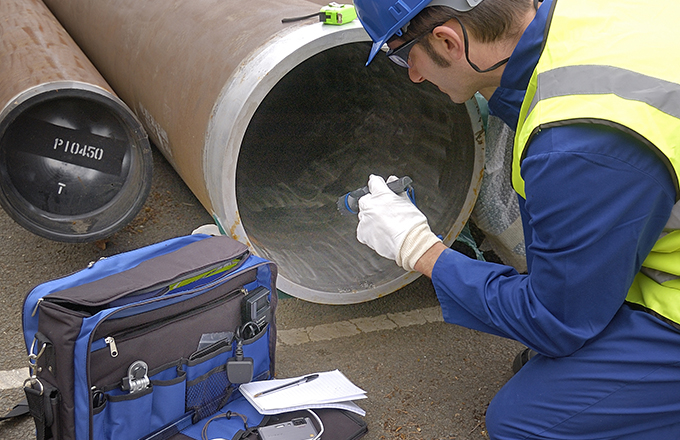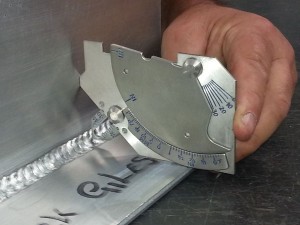Key Factors to Take Into Consideration in Welding Assessment for Quality Guarantee
Welding inspection is an essential aspect of quality control that includes different variables necessary for ensuring the stability of bonded frameworks. Key considerations include the option of suitable evaluation techniques, the certifications of employees, and adherence to industry requirements. The performance of various examination methods-- such as visual, ultrasonic, and radiographic screening-- can dramatically affect the outcomes of top quality analyses. In addition, robust documentation techniques are important for maintaining traceability and promoting continual enhancement. Nonetheless, the interaction of these aspects elevates even more inquiries concerning how they can be enhanced to improve general welding top quality.
Sorts Of Welding Procedures
Welding procedures encompass a selection of techniques used to join products, largely steels, via the application of warm, pressure, or both. One of the most common kinds of welding processes consist of arc welding, gas welding, resistance welding, and solid-state welding.
Arc welding, which includes approaches like Shielded Steel Arc Welding (SMAW) and Gas Tungsten Arc Welding (GTAW), employs an electric arc to generate heat for melting the base metals and filler materials. Gas welding, frequently referred to as oxy-fuel welding, utilizes a flame produced by shedding a fuel gas with oxygen to thaw the steels.
Resistance welding, consisting of place and seam welding, depends on the warmth created from electric resistance to bond materials, typically made use of in automobile production. Solid-state welding processes, such as friction welding and ultrasonic welding, join products without thawing them, using mechanical pressure and frictional warmth.
Each welding procedure has certain applications, staminas, and constraints, making the choice of the ideal technique critical for accomplishing wanted weld high quality and efficiency. Welding Inspection Milwaukee. Understanding these processes is crucial for making sure efficient welding techniques and sustaining top quality assurance in manufacture and manufacturing industries
Examination Methods and Devices
To make certain the integrity and integrity of welded joints, various assessment methods and devices are utilized throughout the welding procedure. These techniques can be generally classified right into non-destructive testing (NDT) and devastating testing (DT) approaches. NDT approaches, which do not compromise the integrity of the welded component, include aesthetic inspection, ultrasonic screening, radiographic screening, magnetic particle screening, and fluid penetrant screening.
Aesthetic examination is the most basic technique, permitting the prompt recognition of surface problems. Ultrasonic screening utilizes high-frequency audio waves to discover inner defects, while radiographic screening uses X-rays or gamma rays to picture the inner framework of welds. Magnetic fragment screening is effective for spotting surface area and near-surface gaps in ferromagnetic materials, and liquid penetrant testing discloses surface-breaking issues by using a colored color or fluorescent penetrant.
On the other hand, damaging screening entails physically examining the bonded joint till failure to evaluate its mechanical properties. Devices such as tensile testing machines, influence testers, and hardness testers are usually made use of in this context. By employing a mix of these devices and methods, assessors can make sure the quality and safety and security of welded frameworks.

Value of Documentation
In the realm of welding inspection, correct documentation functions as a critical backbone for quality control and governing compliance. Paperwork includes a vast array of documents, consisting of weld procedure requirements, examination reports, and non-destructive screening results. These records not just give a sequential account of the evaluation procedure however also function as a reference for future examinations and audits.
Precise paperwork ensures that all welding tasks are verifiable and traceable, facilitating adherence to pertinent sector standards and codes. It ends up being essential throughout the evaluation procedure, permitting stakeholders to analyze conformity with requirements and determine any kind of inconsistencies or problems. Thorough records support efficient communication amongst team members and external auditors, fostering a culture of openness and liability.
In enhancement, properly maintained documents can significantly decrease the risk of costly rework or failures. By guaranteeing that all necessary information is videotaped and accessible, organizations can improve their high quality assurance processes, ultimately enhancing the integrity of the welded structures. As a result, spending time and resources into producing durable paperwork practices is not merely a step-by-step demand but a tactical crucial for achieving lasting success in welding operations.
Employee Credentials and Training
Exactly how can companies make certain the competency of their welding employees? To preserve high standards of quality control, it is vital for organizations to purchase extensive training programs customized to the certain requirements of the welding market. Welding Inspection Milwaukee. This includes not only preliminary training however also continual education and learning to keep workers abreast of developing innovations and methods
Organizations ought to develop clear criteria for workers certifications, including pertinent qualifications and experience in various welding techniques. Employing qualified welding inspectors (CWIs) can enhance the top quality of evaluations, as these specialists possess the necessary know-how to recognize prospective defects and make sure adherence to ideal practices.
In enhancement to technological abilities, organizations must foster a society of security and compliance among their welding personnel. Giving regular workshops and correspondence course can help reinforce the relevance of safety and security protocols and the effects of non-compliance.
In addition, companies need to carry out performance evaluations and responses systems to assess employees competency gradually. By systematically dealing with training needs and promoting a commitment to quality, organizations can enhance their welding evaluation processes, eventually resulting in enhanced product stability and consumer complete satisfaction.
Compliance With Industry Specifications
Following sector standards is critical for making certain the quality and safety and security of welding operations. Conformity with well-known requirements, such as those established by the American Welding Culture (AWS), American National Criteria Institute (ANSI), and International Organization for Standardization (ISO), provides a framework for analyzing the stability of see post bonded structures. These criteria incorporate numerous aspects of welding, consisting of product selection, style specs, and step-by-step strategies.
Welding examinations need to be performed in accordance with these standards to verify that the work meets the necessary top quality standards. This includes aesthetic evaluations, non-destructive screening (NDT), and comprehensive documentation of findings. Making from this source sure compliance not just improves the integrity of the welds but additionally reduces dangers related to structural failures.
Moreover, adherence to sector standards fosters a culture of safety and security and professionalism and trust within the labor force. It develops a benchmark for efficiency and motivates continuous enhancement through regular audits and training. Inevitably, compliance is not simply a regulative requirement; it is a commitment to excellence you can find out more that safeguards both employees and the setting while delivering top quality welding items.

Conclusion

Welding evaluation is a vital facet of quality guarantee that incorporates numerous elements crucial for guaranteeing the honesty of bonded structures.To make sure the stability and reliability of welded joints, numerous evaluation strategies and devices are utilized throughout the welding procedure.In the world of welding inspection, proper documentation serves as a vital foundation for high quality guarantee and regulatory compliance.Welding inspections need to be performed in conformity with these requirements to confirm that the work meets the needed top quality criteria.In final thought, effective welding inspection for top quality guarantee needs a complex strategy that includes the choice of appropriate inspection methods, rigorous adherence to sector requirements, and detailed paperwork of results.